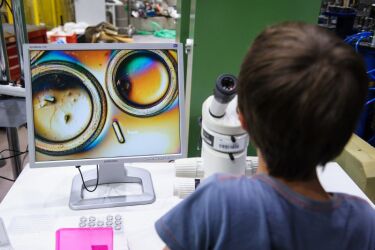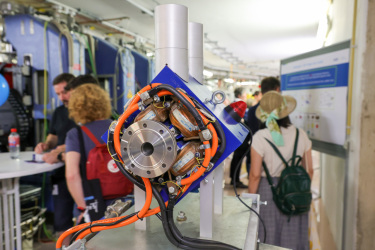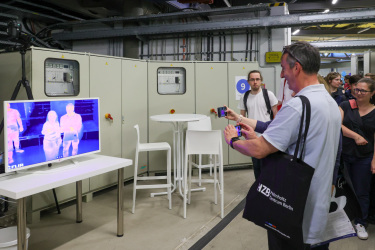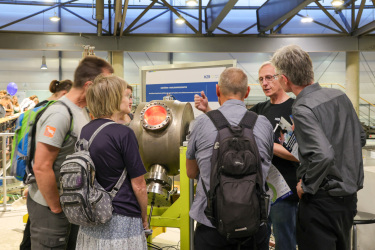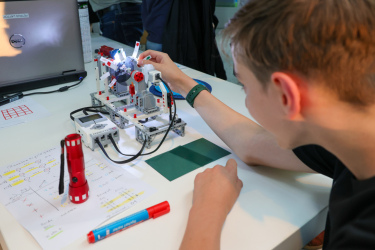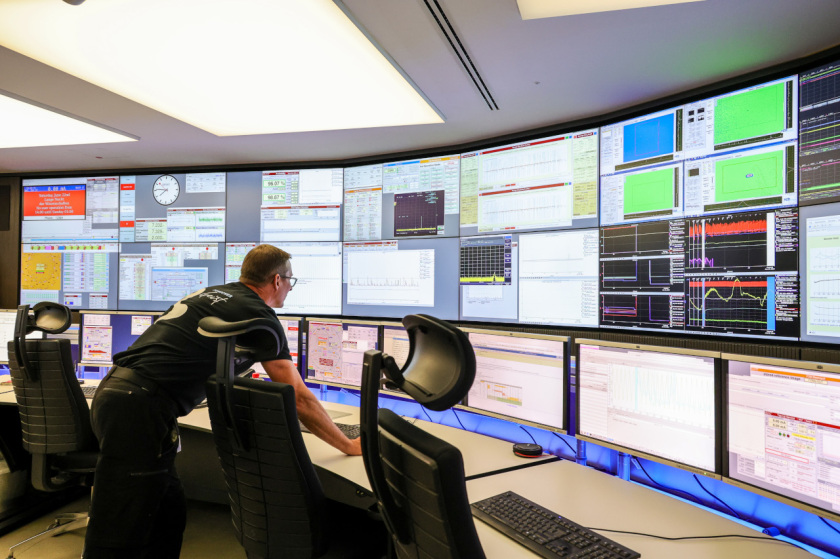© HZB/Phil Dera
The electron storage ring BESSY II with the coveted light
Program details
Tour of the BESSY II X-ray source
The art of measurement: precision measurements for research and industry (Physikalisch-Technische Bundesanstalt)
Nanostructures, thin films and telescope systems are calibrated with X-ray light from BESSY II.
Decoding proteins
Proteins are the building blocks of life. With the X-ray light from BESSY II, researchers can uncover the structures of proteins, develop new active substances against diseases and find out how the plastic PET can be recycled.
How do you crystallise a protein?
We crystallise the protein lysozyme. You can observe how fascinating 3D protein crystals grow from a transparent solution. You can also try your hand at fishing for protein crystals. At the end there will be frozen marshmallows and jelly babies.
Solve the protein puzzle!
Proteins are often the target of drugs. Use a protein model to find out how small molecules bind to a specific protein.
Frosty science
How do you generate really low temperatures? We experiment with liquid nitrogen on the topics of energy conversion, magnetism and superconductivity.
What does light reveal about our substances?
Atoms emit light of different colours. Based on their characteristic colour spectrum, we can determine the chemical composition of a sample.
Filtering with the colour fan
The various experiments at BESSY II each require light at a very specific wavelength. A monochromator filters out the light in the required wavelength from the broad light spectrum. We show how this works.
Controlling light
How can we manipulate and shape the brilliant light from BESSY II according to our wishes? We provide an insight into robotics, artificial intelligence and more.
Electrons accelerate and emit light
The electrons in BESSY II are always racing round in circles - at almost the speed of light. At various stations, we explain how we generate the brilliant light for research.
Troubleshooting with the infrared camera
We use the infrared camera to carry out maintenance work at BESSY II and search for faults. We show how we can recognise bad contacts, overheated components or cables that are too tight.
Keeping an eye on the electron beam
Our diagnostic instruments are the "eyes and ears" with which we monitor the electron beam in BESSY II: What is the position of the beam? How many electrons are orbiting? And what shape is the beam? These questions are crucial for the optimal operation of the facility.
How do bridges remain stable? Making the invisible visible at the BAM Beamline
How do bridges remain stable? Why do metals corrode? And how can materials be improved for the energy transition? The BAM beamline uses X-rays to look deep into the inner structure of materials. This makes it possible to recognise tiny changes that determine stability, durability and safety.
Large magnets guide tiny particles
Electrons actually move in a straight line, but with the help of strong magnets we force them into a circular path. In doing so, they emit energy in the form of X-ray light: synchrotron radiation. Three different types of magnets are used to operate BESSY II.
What are undulators and wigglers?
What are they important for? And what do they have to do with an electron slalom?
Experiments with vacuum
What happens to chocolate kisses in a vacuum? What is the Magdeburg hemisphere? Experience exciting experiments and find out why vacuum is important for our experiments at BESSY II.
Lecture Hall
Battery Village - Experience the battery of the future
How will the battery of tomorrow store more energy, charge faster and become more sustainable? At our interactive stand, you can discover the exciting world of battery research with illustrative experiments. Find out how we use X-ray light from BESSY II to research materials and develop more powerful energy storage systems.
Shaping the future - your ideas, our research
How do you imagine a future worth living? In our World Café, we exchange ideas and discuss your wishes and visions in small groups. Together we will discover what role research can play in shaping a safe and sustainable future.
Stations outside the tour
Foyer BESSY II
HZB as an employer: diversity of professions
Research for a climate-neutral society - that is our mission. To achieve this, we need many people in different professions! We would like to get to know you and show you what the Helmholtz-Zentrum Berlin has to offer as an attractive employer.
Metadata - the key to precision
How important is metadata for science? Find out at our interactive station! Build a LEGO figure using only a vague description - and experience how difficult it is to work precisely without clear instructions from metadata. Then try again with detailed information and experience the difference.
BESSY III: a materials discovery machine of the future
Our new X-ray source BESSY III is due to go into operation in the middle of the next decade. We want to use it to research many new materials. Travel with us into the future and discover the new experiments and research possibilities!
Superconducting accelerator technologies
We are developing new technologies that could be used in next-generation accelerators. We demonstrate different physical effects that are used for superconducting radio-frequency accelerator technology. Carry out small experiments under our guidance!
1st Floor BESSY II
School lab – Experiments full of energy
We need energy for many things in everyday life. But what is behind it when we talk about energy consumption or energy production? We want to answer questions full of energy with lots of hands-on experiments.
The control room of BESSY II
Take a look inside our control room
Catering & Music
Refresh yourselves with delicious food and drinks in front of the BESSY building and relax with music by DJ Carsten.

